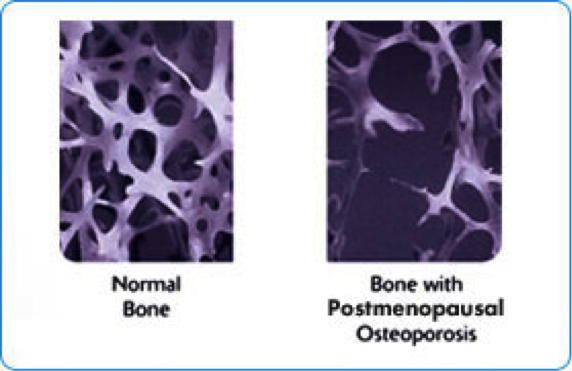Osteoperosis Treatment
You have been diagnosed with Osteoporosis of either the spine, the hip, or both. This information is being given to you to help you make a decision regarding your medical treatment of osteoporosis.
What is Osteoporosis?
Osteoporosis is a disease of the bones. Osteoporosis occurs when the body uses the bone’s calcium storage for other body processes, eventually leading to weakened bones. This weakness can be the source of pain, as the body’s bones give way to muscles that pull them out of proper alignment. The weakness can also lead to fracture of the hip or spine. Most fractures occur after a menopausal woman has a simple “slip and fall” accident in her own home. Unfortunately, the death rate following hip fracture is nearly 80% of women within one year of the hip fracture; this occurs mainly from complications arising from immobility after the fracture!

Who Gets Osteoporosis?
Anyone can develop osteoporosis, as it can be a normal process of aging and decreased hormone production, However, women are more likely than men to develop the disease, and are also more likely to develop the disease earlier in life when the disease can cause earlier than expected complications. If you are underweight, undernourished, or use certain medicines, such as steroids, you are more likely to develop the disease Estrogen is protective over bone loss, so it is no surprise that women who are menopausal develop the disease. People who ingest large amounts of alcohol or caffeine also develop the disease quicker than expected. Caucasians develop the disease more often than non-Caucasians. Certain diseases can also lead to early osteoporosis. Lastly, a family history of osteoporosis may also predict that you may develop the disease earlier than expected.
Does taking calcium alone build bones that have already been weakened?
NO! Most people believe that they can strengthen their weakened bones by taking calcium. However, once you are 30 years old, the body does not strengthen bones with calcium. The only purpose calcium plays if you are over 30, is preventing further bone loss. This means you DO need to keep taking calcium, it just isn’t building your bones back up… it’s being used for your muscles and nerves, and protecting the bone that you still have from being used up instead.
What can I do to build up weakened bones if calcium doesn’t do this?
The only way to rebuild bones after the age of 30 is to take medicines that will help the body do this. These medicines are called biphosphonates. There are a couple biphosphonates on the market today; one is called Boniva, and the other is called Actonel. They both act very similar. You may want to contact your insurance company to see which drug your insurance company covers you to take.
How to Use Biphosphonate
Boniva™ and Actonel™ should be used as prescribed and there are some important things to know before taking the medicine.
- If you take these medicines wrong, you can hurt yourself.
- If you take these medicines wrong, you can actually weaken other bones in your body.
- After taking these medicines, you must stay upright for a full hour.
- You must only take the medicine with an 8 oz glass of water, on an empty stomach.
- You must not eat for a full hour after taking the medicine.
- Do not take the medicine with mineral water, coffee, tea, soda, or juice.
- You must be taking a 500 mg calcium supplement 3 times a day every day for a full month after taking the medicine.
- If you forget to take your medicine the day it is due, wait until the next day to take the medicine.
- Flu – like symptoms
- Back, stomach, arm, leg and or muscle pain
- Heartburn
- Muscle Spasms, twitching, or cramps
- Numbness or tingling in the fingers, toes, or around the mouth
While using biphosphonate you should eat plenty of calcium. Which foods are best?
While taking biphosphonate, you should eat plenty of calcium. Foods rich in calcium are:
- Cheese, Yogurt, Ice Cream, and Milk **
- Green leafy vegetables: Kale, Collards, Spinach, Broccoli
- Iron fortified cereals, breads, grains (look for the words that say “iron fortified”)
- Beans, sesame seeds, and almonds
- Tofu, Salmon and sardines with bones
The Goal is to get about 1200-1500 milligrams of calcium per day.
You must get your calcium while using biphosphonate. Take a calcium supplement 500 mg at a time, 3 times daily. Your body will not absorb more than 500 mg at a time. Don’t be fooled into taking 1500mg once a day. Do not take calcium and iron supplements together; the calcium will make it so that you do not absorb your iron.
What follow up care will you need? Is there any other things I need to know?
Your blood levels of calcium will be checked after your first dose of Boniva or Actonel.
In one year, a follow up Dexa scan will check to see if your bone has improved.
Follow the plan of care, take your calcium, and reduce your slip and fall hazards. Read “Bone Health” and follow it’s suggestions to prevent further bone loss and injury.
GOOD HEALTH, (not good luck), this year, treating your osteoporosis!